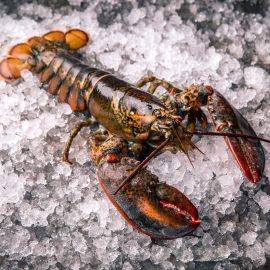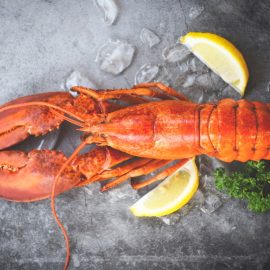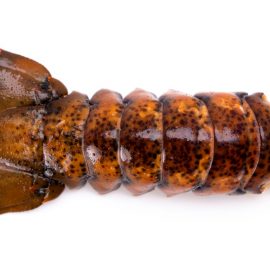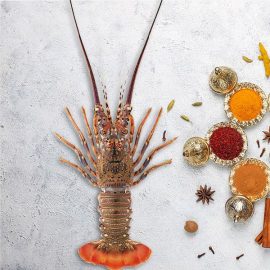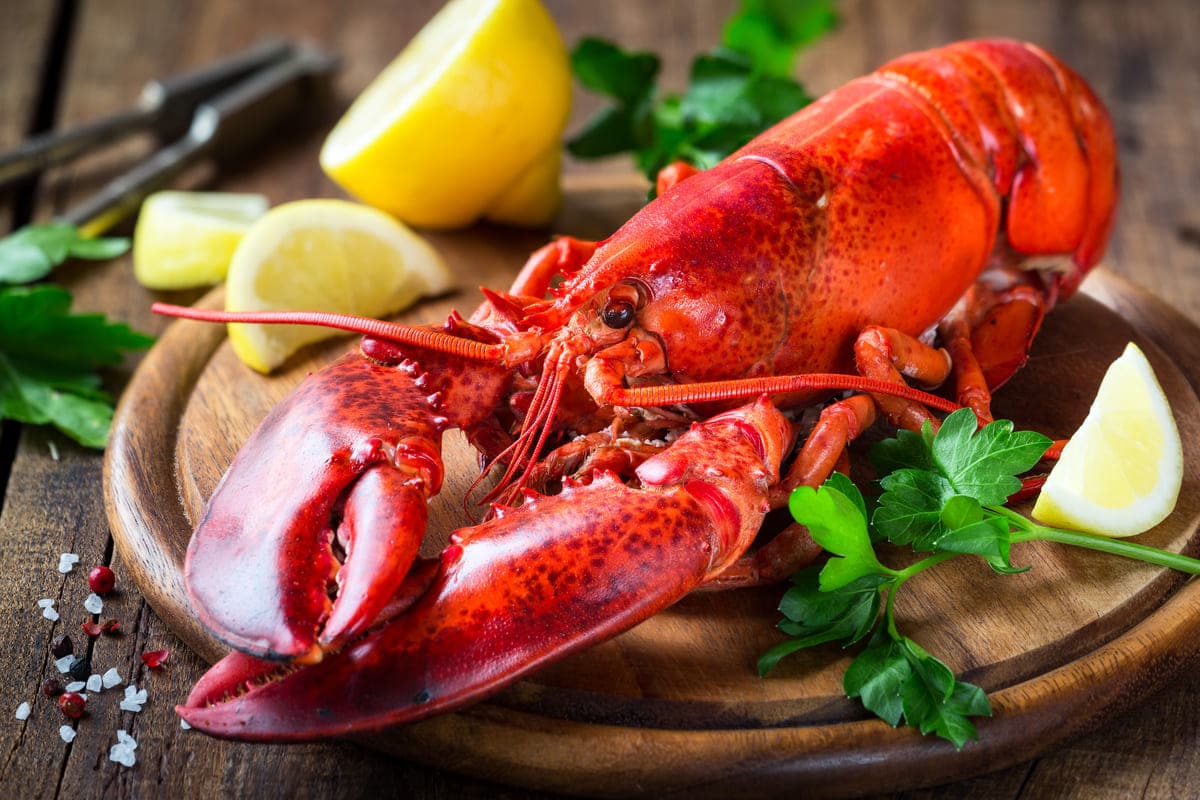
Introduction
Lobster is the common name for several large marine crustaceans of the infraorder Nephropidae, including clawed and spiny lobsters. Originally hailing from coastal and ocean waters around the world, they are among the most economically essential invertebrates, with some species harvested for human consumption.
The two most common species of lobster – the American Lobster (Homarus americanus) and the European Lobster (Homarus gammarus) – are known for their impressive longevity and regenerative abilities. With the right conditions, these lobsters can live up to 50 years.
Archaeological discoveries suggest that the Ancient Greeks and Romans first enjoyed lobsters as a luxury delicacy. It remains a beloved seafood in many parts of the world today.
Description
True lobsters have large antennae and two large claws, while spiny lobsters have no claws but possess small antennae and at least six legs, with the first pair of lobster legs forming the pincers. These species vary in characteristics and colours, ranging from white to grey, reddish-brown and greenish-blue, with most species having a hard, firm carapace and two or more large claws or antennae.
Out of all species, the American Lobster is the largest, most popular, and most abundant species. Its head characterises it with long antennae, two large front claws, reddish-brown body colour, and a fan-like tail. American Lobsters are highly sought-after for their nutritional value and the essential proteins, vitamins, and minerals they offer.
Other species of Lobster include the Dublin Bay Prawn (Nephrops norvegicus) and the Norway Lobster (Homarus gammarus), commonly enjoyed worldwide.
Physical Characteristics
Lobsters are the common name for several large families of crustaceans and come in various shapes & sizes, ranging from around 9 inches to a maximum of 3 feet. Their bodies are usually cylindrical, with an elongated exoskeleton and a hard carapace covering their exoskeleton.
The colour of the carapace may vary depending on the species, typically being mottled brown, red, and blue or yellow, green and purple. At the end of the body is a distinct, triangular tail. The head has two large, feeler-like antennae, sharp mandibles, and two to five pairs of tiny eyes. The claws may vary in shape and size and may be patterned or plain in colour, including other forms of lobsters. Lobsters can weigh up to 30 pounds.
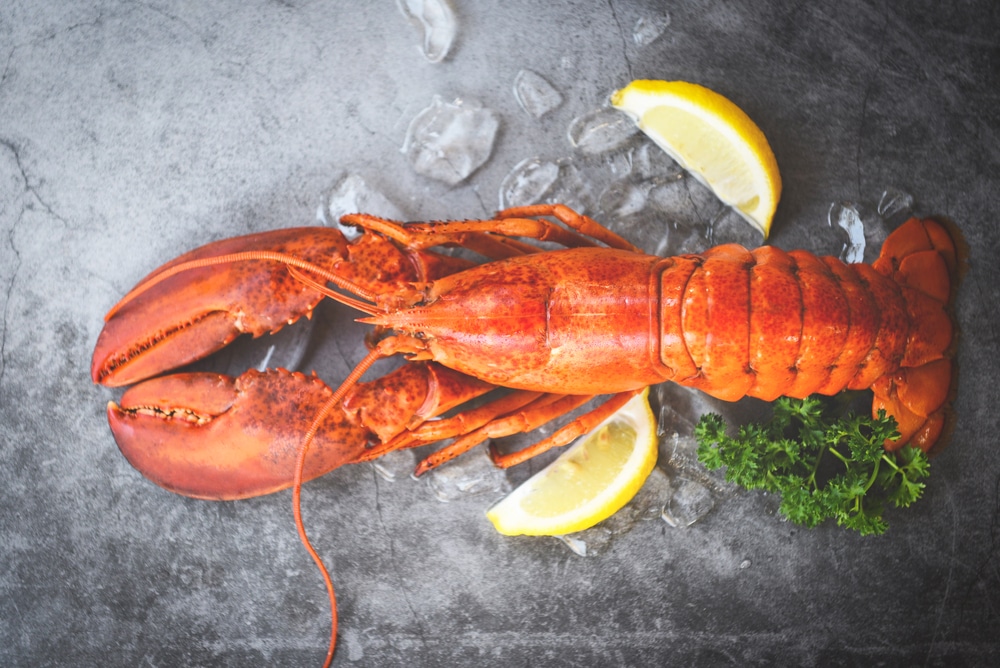
Habitat and Feeding
Lobsters live in all oceans except the polar regions’ icy waters, typically in temperatures ranging from 38-59F (3-15C). Though abundant in coastal waters surrounding North America, Europe and Asia, lobsters can inhabit the continental shelf of oceans, rivers and streams and venture as far as 1,000 metres deep.
In the wild, lobsters are primarily nocturnal and are solitary animals, although they sometimes form small clusters in rocky areas and along coastlines. Lobsters are most commonly found in crevices, crevasses, and reefs, making their homes in abandoned shipwrecks, natural caverns, sea-weed beds and coral reefs.
They have an excellent sense of touch and movement and use their antennae to sense their environment and communicate with other organisms in the area. Their strong claws are used to capture and eat food and defend themselves from predators. Lobsters are primarily scavengers, feeding on various organisms, including dead plants and animals, sea urchins, fish, worms, and other crustaceans.
They have an average lifespan of 50 years in their original wild habitats, although this is usually much shorter in captivity. In addition, lobsters have been found to possess the remarkable ability to regenerate lost limbs.
Distribution of Stocks
Lobster harvesting has been a major part of the maritime culture for centuries and is still a significant industry in many countries today. There are sizeable American Lobster (Homarus americanus) landings in the northeastern United States, Canada, Australia, and New Zealand. Lobster is a highly sought-after seafood delicacy, and commercial lobster fishers have employed various trapping and handling methods to capture it.
In the western Atlantic, the American lobster can be found in estuarine and coastal habitats from Newfoundland south to Florida and Brazil to Argentina in the south Atlantic. In the eastern Atlantic, the lobsters range from Norway to Morocco.
The Mediterranean sea supports American and European lobster, found in the Black Sea, the Azores, and Portugal. Young lobsters live in shallow estuarine environments, at depths of only 5-20 meters, until they reach maturity.
Fisheries and Uses
Lobster is a highly valued species worldwide, as it is a popular seafood delicacy used in dishes ranging from salads to pasta. Most lobsters can be found in coastal waters and either caught wild or farmed through aquaculture. The lobster industry is an essential contributor to the economy of many countries.
Lobster fisheries are found across the globe in countries like Canada, the United States, Mexico, Brazil, France, Norway, Wales, Germany, China, New Zealand, Iceland, and Greenland. These countries are primarily divided into two categories: wild-caught and aquaculture. Wild-caught fisheries involve local fishermen who use boats, traps or dredges to capture the lobsters from their natural habitats. In contrast, aquaculture fisheries are maintained and operated commercially to maximise production.
Population and Conservation
Unfortunately, lobster populations worldwide face many threats, including climate change, overfishing, habitat destruction, water pollution, and ocean acidification.
In particular, ocean acidification is a significant concern for lobsters and other marine life, as it can disrupt the delicate balance in their environment, resulting in decreased food sources for lobsters and other organisms.
To protect the health and viability of lobster populations, many organisations are working towards promoting sustainable fisheries and creating protected areas where lobsters can flourish. With these efforts, scientists hope that lobster populations will remain healthy and viable.
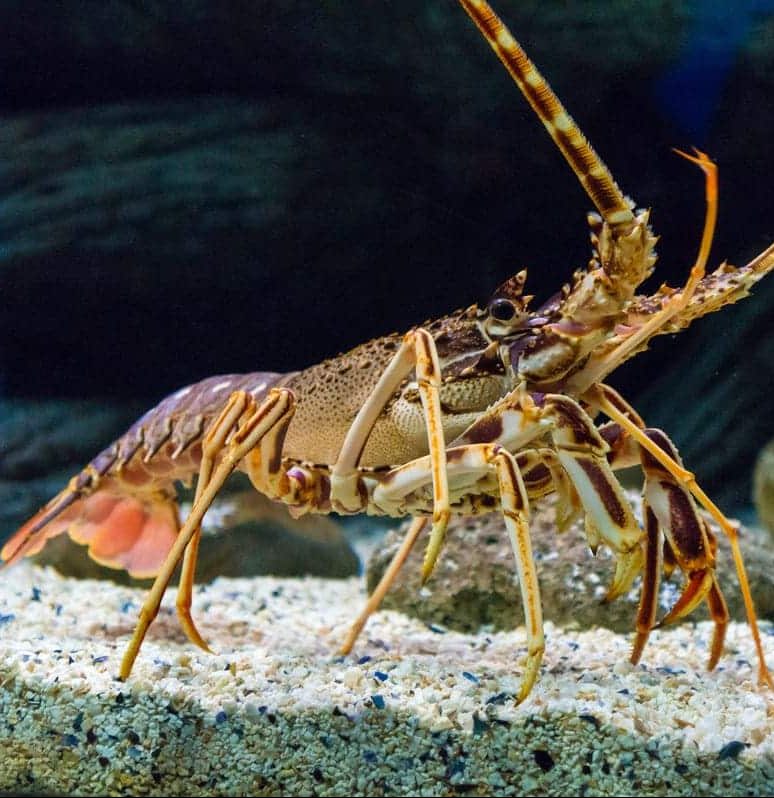
Conservation Status
Humans have been harvesting lobsters for food and income for thousands of years. Today, lobsters are sold in commercial fisheries and are popular seafood in many parts of the world.
Due to the significant demand for lobsters, the introduction of lobster farming has become necessary to generate more sustainability and provide more opportunities to meet the global market.
In recent years, conservation efforts by different organisations worldwide concerning protecting lobsters from overfishing and other threats, understanding their behaviour and promoting their appropriate habitat have been successful. The research conducted on lobsters has provided a greater insight into the species and has assisted in conserving their populations. This research has helped to identify the threats the species face and has supported the development of management strategies to mitigate these threats.
Sustainable Fishing Practices
Sustainable lobster fishing is done responsibly to preserve the lobster population, maintain a healthy marine environment, and ensure enough lobsters in the future to supply the market’s demand.
Numerous campaigns have been targeted to encourage responsible harvesting and consumption of lobster, and technologies such as biodegradable searchlights, cameras, and autonomous fault detection systems have been developed to improve harvesting practices.
Various measures have been taken to ensure the sustainability of lobster fishing, including the introduction of catch quotas, fishing gear regulations, and the creation of Marine Protected Areas.
Lobster’s Diet
Lobsters are carnivorous and feed on various organisms on the ocean floor, including molluscs, crustaceans, worms and small fish. They may also become the prey of their predators, which include other crustaceans, birds, and large fish.
Reproduction
Female lobsters drop coral eggs attached to their underside during the reproductive season, usually spring and summer. She may carry them for up to 12-13 months when she will moult multiple times.
The eggs must incubate near a food source, so the female will make several trips to the ocean floor to feed. Once hatched, the larvae (or megalops) are free-floating and planktonic. They moult several times to reach maturity and will settle in the same area where they were born.
Life Cycle of Lobsters
Lobsters inhabit waters where temperature and salinity are generally consistent, typically on the ocean floor. Lobsters start as eggs attached to the mother and then hatch as tiny larvae. These larvae drift with the ocean currents and feed on plankton until they moult and eventually settle in their adult habitat, typically the ocean floor. The moulting process can be triggered by environmental factors or the lobster reaching a specific size and age.
During the moulting process, the lobster increases its size by absorbing fluids and stored energy into its new exoskeleton. The moulting process occurs several times during their youth until they become adults. Once fully mature, most lobsters become sexually mature after five years and mate annually.
Lobsters are long-living creatures, with a lifespan of up to 100 years and can also grow to be larger than other seafood, up to two feet in length. The blue colouration of their blood (as opposed to the clear or whitish colour of other seafood) is caused mainly by copper.
Classification
Members of the Nephropidae family are often divided into ten genera, with the most common species including Homarus americanus, Homarus gammarus, Panulirus interruptus, Panulirus japonicus, Panulirus argus, Jasus edwardsii, Homarus africans, Homarus capensis, Thymopides grobbeni, Thymopides alcocki, and Thymops birsteini.
Etymology
The word ‘lobster’ comes from the Old English “loppestre”, which means “spider”. It is thought that the name is derived from the lobster’s long pair of antennae. The scientific genus name for the species Homarus americanus is derived from Latin, where “homo” means man and “arus” means a tool or weapon, referring to the large pincers of the lobster.
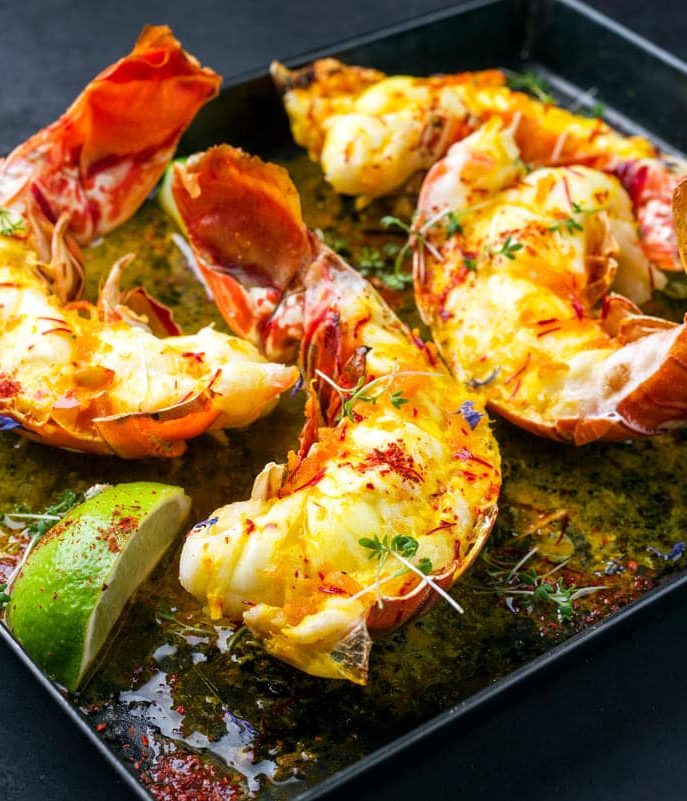
Culinary Interest
The diverse flavour of live lobsters can be further explored in its vast array of culinary practices, from different regional techniques such as grilling, baking, boiling, and steaming, resulting in a wide range of flavour profiles, making Lobster a highly sought-after delicacy.
Lobster is appreciated for its sweet and tender meat. From succulent Lobster rolls to flavorful Lobster Margaritas, many unique, delicious lobster recipes can be created utilising this gourmet seafood delicacy. With an array of accompaniments, side dishes, and cooking methods, Lobster can be prepared in numerous creative ways guaranteed to satisfy any palate.
Significance
Lobsters have been a significant component in the functioning of coastal ecosystems, classifying them as keystone species; the absence of lobsters from the environment may result in substantial damage to the ecosystems.
Also, lobsters have been an essential part of human culture since ancient times and were believed to have medicinal properties. Ancient Greeks and Romans consumed lobsters, with Roman Emperor Vitellius even feeding them to his guests.
By the 1700s, lobsters had become increasingly popular among European diners and were exported to North America, where they continue to be popular today. Lobster fishing and cultivation in the wild became more widespread in the 19th century. Lobster has remained an important species on the planet thanks to advances in aquaculture and commercial fishing.
Uses
Humans have eaten lobsters since the dawn of time. It is often regarded as a delicacy, particularly in the Western world. The lobster fishing industry is vital commercially, and lobsters are caught in fisheries globally.
Lobsters are also used in medical research, producing an insulin-like hormone. Depending on the species, a lobster can live up to 50 years.
Popularity and Availability
Lobster is a popular delicacy that is enjoyed widely around the world. It is known for its delicious flavour and tender texture, which are both genuinely incomparable. With so many varied cooking techniques, you can create delicious meals every time.
Lobster is available in many forms, including whole, split, claw meat, knuckles, and tails. It is best to purchase lobster as soon as possible and store it in a cold environment such as a refrigerator or freezer for up to three days.
Nutritional Values
Nutritionally, lobsters are an excellent source of protein, contain few calories, and are high in minerals, vitamins, and essential fatty acids. As a lean source of protein, lobsters make an excellent choice for any meal due to their low-calorie content.
Health Benefits
Not only is lobster meat a delicious source of protein, but it also has numerous health benefits. It is low in fat and contains 200 kcal per 100g, 19g of protein, 0.3g of fat, and 0.4g of carbohydrates.
Additionally, it contains essential minerals such as iron, potassium and zinc, as well as iodine, and the mineral selenium, which is known to play a role in the prevention of cancer.
Eating lobster in moderation can provide many health benefits. Its high protein and essential fatty acid content support heart health, while its micronutrients, such as magnesium, iron, phosphorous, zinc, vitamin B6, and selenium, support healthy skin, bones, and immunity. As such, adding lobster to a balanced diet can ensure an overall improvement in health.
Versatility
Lobster is a popular ingredient in many dishes across cultures. Everything from classic French recipes like Lobster Thermidor to the innovative Lobster Fries and Lobster Poutine makes frequent use of lobster. This typical crustacean is found in signature dishes in many different countries.
Lobster is renowned for its versatility, with it available in various forms, including cooked, boiled, frozen, and canned. This helps make lobster an even more appealing option for those looking for something different, with many creative recipes being made to take advantage of its unique qualities. Lobster has also been represented in pop culture as a valuable and luxurious commodity, featuring in movies, television shows, and other media.
Taste and Texture
Lobster is commonly regarded as one of the tastiest and most luxurious seafood. Its flavour is often described as having a mix of sweet, salty, buttery and earthy notes, with a hint of iodine. Depending on the type of lobster and how it is prepared, the taste can vary significantly.
Most experienced palates will generally find lobster a pleasant and appealing flavour, making it a popular choice for at-home and restaurant cooking. With the right ingredients, lobster dishes can be served to stunning effect.
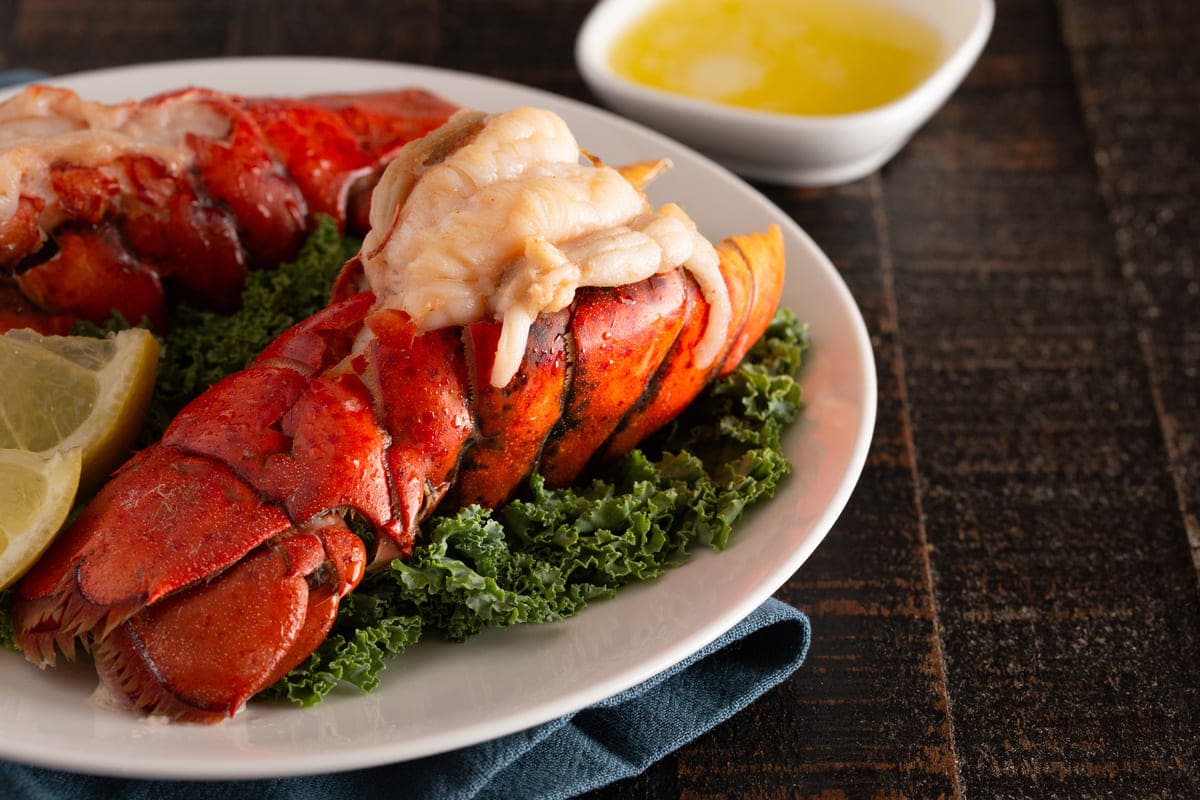
Cooking Lobsters
The flavour of lobster will depend on the cooking method and the sauces and herbs used; boiled or steamed lobster will have a sweeter flavour, while grilled or baked versions will bring out its more briny, salty taste. Lobster is ideal for creating a diverse range of delicious dishes, including soups, bisques and chowders, and can be further enhanced by adding lemon, butter, garlic and herbs.
Preparation
Before preparing a lobster for cooking, it is essential to confirm it has already died. Boiling a live lobster will inflict severe pain and adversely affect its flavour. After the death of the lobster can be verified, the preparation process can begin.
The preparation starts with cutting the lobster lengthwise from its head to the tail. Alternatively, a cracker may be employed to break the lobster in half. In addition, it is necessary to remove the dark brown gastrointestinal tract, which runs along the centre of the lobster.
The next step would be the extraction of the tomalley, a greyish-green paste found in the middle of the lobster. Depending on the lobster’s age, the tomalley may also be in a separate sac near the tail.
Lastly, the female lobster will make available a mass of black eggs called the roe, which must also be removed before cooking.
- Baking and Steaming- The two most popular methods for cooking lobster are boiling/steaming and baking. A rubber band method is recommended when cooking a live lobster, where a rubber band is placed around the lobster’s pincers to keep it immobilised.
- When steaming, place a rack inside a covered pot. Boiling instructions will depend on the weight of the lobster; for a 1-pound lobster, boil for 16 minutes, and for each additional pound, an additional 8 minutes.
- For baking, the lobster should be cooked in the oven at 375-400 degrees Fahrenheit for approximately 12-15 minutes for a 1-2 pound lobster. Furthermore, cutting the lobster’s tail before cooking and then removing it from the heat source once it has turned bright red is recommended for all cooking methods.
- Grilling – Grilled lobsters can be cooked with a marinade or foiled from the shell, tail, and pincers. To grill the lobster, butterfly the lobster and rub it with olive oil and seasoning before placing it on a medium-heat grill for 8-10 minutes on each side.
Serving
Lobster and vegetables is a versatile dish that works as a main course or a side dish. By combining all of these flavours, a colourful and flavorful dish is easily achievable. Cooks are encouraged to use the vegetables of their choice to create a dish tailored to their tastes.
Side Dishes
Many cuisines around the world feature lobster as a popular dish, typically accompanied by side dishes that contrast the lobster’s texture and flavour. Classic accompaniments to lobster dishes are potatoes, coleslaw, and salads, while more exotic options like fennel, squash, and asparagus are also available. Selecting side dishes to accompany a lobster meal is essential to ensure they complement the entree.
Bread is a common accompaniment to lobster dishes. Sourdough, baguettes, and garlic bread are all excellent types of bread to serve with lobster, as well as more traditional accompaniments such as lobster butter, tartar sauce, lemon wedges, and melted butter.
Creative Options
Chefs across the globe explore unique ways to prepare lobster, creating an ever-growing repertoire of creative recipes. Noteworthy dishes include lobster paella, lobster scampi, lobster enchiladas, lobster frittata, lobster poutine, curried lobster, and stuffed lobster tails.
Lobster plays a vital role in the cuisines of many different cultures and countries. In Asia, lobsters are commonly used to make curries and stir-fries. In France, classic dishes such as Coquilles St. Jacques are popular. It is also possible to find lobster tacos, nachos, and casseroles in many restaurants. Moreover, lobster can be found in soups, salads, and sandwiches.
Lobster is especially popular in the United States and Canada, where it is the star of regional favourites such as Maine lobster dinners and Maritimes boils. Other countries have developed their lobster dishes, such as the spicy oven-roasted lobster of Korea.
Suitable Sauces & Spices
When served hot, butter-based sauces, such as melted butter, butter and wine sauce, or beurre blanc, can work wonders in enhancing the flavour of the lobster meat. The natural sweetness of this seafood also works well when complemented by lighter accompaniments such as salads, garnishes, or marinades.
Cooking Techniques
You can cook lobsters in multiple ways to obtain the perfect flavour. These techniques include boiling, steaming, grilling, roasting, broiling, stuffing, sautéing, barbecuing and cooking fresh.
Simple ingredients such as herbs, butter and breadcrumbs can increase the flavour, depending on the chef’s preferences. Temperature and timing also vary greatly when cooking a lobster accordingly to the size, as overcooking can end with a tough and flavourless piece of meat. It is vital to use a court bouillon to prevent overcooking.
Popular Lobster Recipes
In French cuisine, Lobster Thermidor is a classic dish made with lobster combined with traditional creamed ingredients, while Lobster Newburg is a more rich seafood stew made with butter, sherry, and cream.
American recipes make use of lobster in many popular dishes. Lobster Rolls often appear, served with lobster meat, mayonnaise, herbs and a toasted hotdog bun. A classic comfort food, Lobster Macaroni and Cheese typically contain lobster, cheese and other ingredients. Lobster Salad is also popular, prepared with cooked lobster, lettuce, and mayonnaise.
European recipes often employ lobster in desserts, such as Lobster Flan and Lobster Souffl. Chefs in many parts of the world also prepare creative dishes like Lobster Fries and Lobster Poutine for a unique take on classic seafood.
Lobster is commonly used in Chinese cuisine to stir fry dishes and soups. Lobster Thermidor Pot Pie is a savoury blended dish of Lobster, mushrooms and other ingredients, topped with a crust. Lobster Fra Diavolo is another classic dish, combining lobster with spicy tomato sauce, while Lobster Scampi typically features lobster cooked in butter, lemon juice, garlic and oregano.
Cultural and Culinary Similarities/ Cultural uses
Lobsters have a long history that goes back to ancient civilisations. The Romans were renowned for their love of the crustacean, and Native Americans were among the first to harvest them in the New World.
During the Industrial Revolution, the shells of lobsters served as fertiliser and meat for canning. Lobster is still popular in the West and prized for its taste, versatility, and high-protein content.
Conclusion
Lobster stands out as one of the unique types of seafood. With its deep-sea habitat and the ability to be cooked and prepared in an extensive range of dishes, Lobster has established itself as a luxury item, and an ingredient served in high-end restaurants.
Its flavour and texture are unrivalled and used in an endless array of dishes. From traditional recipes to modern creations, there will surely be a lobster dish to please any.
